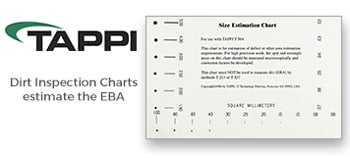 Search
Search
Use the search bar or filters below to find any TAPPI product or publication.
Filters
Publications
Level of Knowledge
Collections
Journal articles

Magazine articles

Energy saving potential of interstage screen fractionation for production of board grade BCTMP, TAPPI Journal August 2023
ABSTRACT: Over the last few decades, the continuing decline in mechanical pulp-based grades has led pulp producers to modify operations and implement measures to reduce production costs in order to stay competitive. In spite of a considerable effort to reduce energy consumption, the latter is still a major portion of production costs in the process of making bleached chemithermomechanical pulp (BCTMP). In this study, we evaluated the impact of interstage screening fractionation (ISSF) and secondary refining strategy for producing BCTMP with the objective of reducing refining energy consumption while maintaining or improving bulk and strength properties. In the first step and to establish a baseline for a mill’s existing configuration, the collected primary refined pulp and reject streams from the ISSF were refined in a high consistency (HC) refiner to target freeness levels. The accepts and refined rejects streams were recombined, and their properties were compared to those of the refined primary pulp. The results showed that, at a given freeness of 400 mL and compared to the control case (without fractionation), the ISSF using an 0.070 in. basket followed by rejects refining could lead to about 25% energy saving in the second stage HC refining. Handsheet properties showed that utilization of ISSF could produce BCTMP with higher bulk and similar average fiber length and tear index. However, a slight reduction in tensile strength was observed. In the second set of trials, the primary refined pulp and the rejects from the ISSF using the 0.070 in. basket were refined by a low-consistency (LC) refiner. The results showed that, at the same freeness of 400 mL and compared to refined primary pulp, the ISSF saved about 26% in net LC refining energy. At a specific edge load (SEL) of 0.4 J/m, the produced pulp had similar bulk and strength properties compared to those of the control sample. A higher SEL of 0.6 J/m in LC refining could further decrease net refining energy consumption; however, it also led to reduction in fiber length, bulk, and strength properties.
Journal articles

Magazine articles

Going the Distance with Utah PaperBox’s Trim Removal Solution, Paper360º January/February 2022
Going the Distance with Utah PaperBox’s Trim Removal Solution, Paper360º January/February 2022
Journal articles

Magazine articles

An Effective Solution for Dryer Section Deposition, Paper360º November/December 2024
Journal articles

Magazine articles

External fibrillation of wood pulp, TAPPI Journal June 2023
ABSTRACT: Pulp refining produces external fibrillation consisting of fibrils tethered to fiber surfaces, in addition to loose fibrils and fines. Both contribute to a larger bonding area that increases paper strength, but tethered fibrils have less likelihood of being washed out during papermaking. This study postulates the mechanism by which refining produces external fibrillation and the optimum conditions for doing so.The postulated mechanism is surface abrasion during sliding of fibers in refiner gaps. External fibrillation occurs when forces are great enough to partially dislodge fibrils from fiber surfaces, but not large enough to break the fibrils. The refining intensities to achieve these forces were determined by a mathematical model and experiments using a laboratory disc refiner. The optimum intensities in terms of specific edge load (SEL) for chemical pulps were about 0.1 J/m for hardwoods and 1.0 J/m for softwoods. An extension of this study suggested that abrasion may also account for most of the energy consumed in the mechanical pulping process.
Journal articles

Magazine articles

Fapajal Tissue: Old, New & Customer-Centric, Paper360º March
Fapajal Tissue: Old, New & Customer-Centric, Paper360º March/April 2018
Journal articles

Magazine articles

Editorial: The Laboratory of Soft Materials & Green Chemistr
Editorial: The Laboratory of Soft Materials & Green Chemistry at North Carolina State University, TAPPI JOURNAL July 2017
Journal articles

Magazine articles

PM Upgrade Requires a Comprehensive Condition Monitoring Solution, Paper360º January/February 2023
Journal articles

Magazine articles

Breaking Traditional Maintenance & Reliability Thinking, Paper360º September/October 2022
Journal articles

Magazine articles

Editorial: Coating & Graphic Arts, Process Control papers ho
Editorial: Coating & Graphic Arts, Process Control papers honored at PaperCon, TAPPI JOURNAL June 2017
Journal articles

Magazine articles

Novel test method for measuring defects in barrier coatings, TAPPI Journal November 2022
ABSTRACT: In the last several years, activity to develop water-based barrier coatings (WBBCs) that meet challenging packaging performance requirements has increased dramatically. Cellulose-based packaging solutions can provide a more sustainable packaging option for replacing single-use plastic-based options like extrusion-based and laminated materials. An advantage of WBBCs is the opportunity to reduce the coating thickness applied, as long as the barrier requirements can be met. A challenge that must be overcome is the ability to maintain a defect and pin-hole-free coating layer after coating and drying to retain the barrier performance. Many formulation and coating parameters can affect the barrier coating layer quality; however, methods for detecting more subtle differences in these types of studies are not widely available. Work was carried out to develop a quantitative technique for detecting and measuring the quantity and size of defects in the barrier coating layer. A test method has been developed using a combination of dyed oil and image analysis to be able to characterize the imperfections in the coating surface. The use of dyed oil serves two purposes. First, it better simulates the types of materials, in this case, oils and grease, for which the barrier coating is expected to hold out. Second, it also provides contrast between the coating and failure points for testing. An image analysis technique is employed to characterize the number and size of the imperfections. For the former, it reduces the testing time required if a quality control or laboratory technician counts the dots. For the latter, it assists with judgment on the source of the root cause of the imperfection, such as base sheet defects, coating dispersion issues, or perhaps micro-blisters in the coating, as some examples.To show the benefit of this technique, several pilot coating studies were designed to see if the new technique could be utilized to detect differences in WBBC performance. Both process and chemical variables were evaluated. With refinement, it is believed this technique can be utilized in development work, as well as for a potential quality control technique for manufacturing of coated paper and paperboard products.





